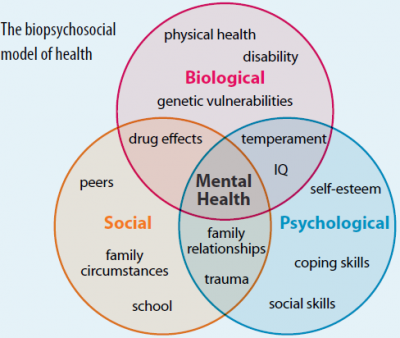Biopsychosocial Model
Introduction[edit | edit source]
The Biopsychosocial model is a conceptual model that suggests that in understanding a person's medical condition it is not simply the biological factors to consider, but also the psychological and social factors [1].
- Bio (physiological pathology)
- Psycho (thoughts emotions and behaviours such as psychological distress, fear/avoidance beliefs, current coping methods and attribution)
- Social (socio-economical, socio-environmental, and cultural factors suchs as work issues, family circumstances and benefits/economics)
This model is commonly used in chronic pain, with the view that the pain is a psychophysiological behaviour pattern that cannot be categorised into biological, psychological, or social factors alone. There are suggestions that physiotherapy should integrate psychological treatment to address all components comprising the experience of chronic pain.
The diagram below shows an example of this model.
Diagram of the Biopsychosocial model. [2]
References[edit | edit source]
- ↑ Gatchel, Robert J., Peng, Yuan Bo, Peters, Madelon, L.; Fuchs, Perry, N.; Turk, Dennis C. 2007 The biopsychosocial approach to chronic pain: Scientific advances and future directionsfckLR Psychological Bulletin, Vol 133(4), 581-624
- ↑ http://savvywillingandable.wordpress.com/2013/09/25/the-biopsychosocial-model-explained/







